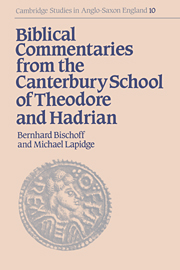Book contents
- Frontmatter
- Contents
- Preface
- List of abbreviations
- 1 Introduction
- 2 Archbishop Theodore
- 3 Abbot Hadrian
- 4 Theodore and Hadrian in England
- 5 The sources of the Canterbury biblical commentaries
- 6 The nature of the Canterbury biblical commentaries
- 7 The manuscripts
- Texts and translations
- Commentary to the texts
- Appendix I Additional manuscript witnesses to the Milan biblical commentaries
- Appendix II Two metrological treatises from the school of Canterbury
- Fig. 1 Cilicia and Syria
- Fig. 2 Constantinople in the seventh century
- Fig. 3 Churches and monasteries of seventh-century Rome
- Fig. 4 Cyrenaica and the Pentapolis
- Fig. 5 Campania and the Bay of Naples
- Fig. 6 Palestine
- Bibliography
- Index of Old English words quoted in the texts
- Index of Greek words quoted in the texts
- Index of names cited in the texts
- General index
Appendix II - Two metrological treatises from the school of Canterbury
Published online by Cambridge University Press: 08 January 2010
- Frontmatter
- Contents
- Preface
- List of abbreviations
- 1 Introduction
- 2 Archbishop Theodore
- 3 Abbot Hadrian
- 4 Theodore and Hadrian in England
- 5 The sources of the Canterbury biblical commentaries
- 6 The nature of the Canterbury biblical commentaries
- 7 The manuscripts
- Texts and translations
- Commentary to the texts
- Appendix I Additional manuscript witnesses to the Milan biblical commentaries
- Appendix II Two metrological treatises from the school of Canterbury
- Fig. 1 Cilicia and Syria
- Fig. 2 Constantinople in the seventh century
- Fig. 3 Churches and monasteries of seventh-century Rome
- Fig. 4 Cyrenaica and the Pentapolis
- Fig. 5 Campania and the Bay of Naples
- Fig. 6 Palestine
- Bibliography
- Index of Old English words quoted in the texts
- Index of Greek words quoted in the texts
- Index of names cited in the texts
- General index
Summary
One of the recurrent interests of the Canterbury glossators was metrology, that is, the equivalence of weights and measures of various kinds: of volume, of liquid and solid measures, of length and distance, of value especially of coinage, and so on (see above, pp. 262–3). Any Anglo-Saxon scholar of the early Middle Ages will have been faced, in the texts he studied, with the different terminologies for weights and measures in Hebrew, Greek and Latin literature, and with the complex relationships existing between them. And however complex such relationships might be, they were complicated still further by the question of how they related to the native Anglo-Saxon system of reckoning weights and measures. There were very few books which the Anglo-Saxon scholar could consult for guidance on these matters: Epiphanius wrote a treatise in Greek which has not survived in its entirety in that language (the only complete surviving version is in Syriac: see CPG II, no. 3746 and above, p. 212), and which would in any case have been inaccessible to a Greekless reader. In Latin there are very concise treatments in Eucherius's Instructiones and in Isidore, Etym. XVI.xxv–xxvi, but neither of these accounts is comprehensive enough to be much help to an Anglo-Saxon scholar wishing to interpret his native system in terms of the ancient systems. In view of these circumstances, it is not surprising that Theodore and Hadrian should have addressed themselves to the task of explaining the various ancient systems and attempting to relate them to the Anglo-Saxon system. Their explanations are found throughout the Canterbury biblical commentaries, as we have seen (above, pp. 262–3).
- Type
- Chapter
- Information
- Publisher: Cambridge University PressPrint publication year: 1995



